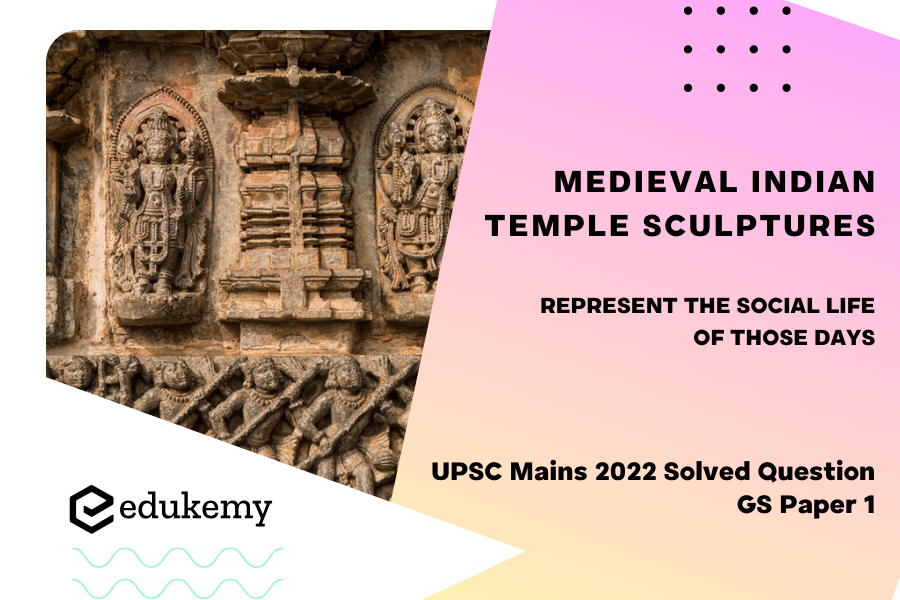UPSC Mains General Studies Paper – 1 Mains 2022
Indian Culture – Salient aspects of Art Forms, Literature and Architecture from ancient to modern times.
UPSC Mains Civil Services IAS Exam Question Paper – 2022
Contents
Decoding the Question
- Start with explaining the key word ‘sculpture’.
- Discuss the structure and regions of the Medieval Indian temple sculptures
- Explain the impact on social life of the Medieval Indian temple sculptures.
- Conclusion to accordingly.
Answer
Introduction
‘Sculpture’ is a form of art that has been used throughout history to represent and depict various aspects of society and culture. In Medieval India, temple sculptures were often used to depict the social life of that time period. The work changes across time and space since it is a tactile creative form that exists in the same space as its audience. They may also depict religious or mythological scenes that were significant in Medieval Indian culture. These sculptures were often highly detailed and intricately carved, making them valuable historical and cultural artefacts.
Temple sculptures During the Medieval
- Medieval Indian temple sculptures are some of the most important historical and artistic treasures of India. Medieval India was a time of great artistic and cultural ferment, with a rich tradition of religious and secular sculpture.
- They are not just beautiful works of art, but also powerful representations of the social life of the people who lived during that time. Through these sculptures, we can learn about the beliefs, customs, and lifestyles of the people who lived in India during the Medieval period.
- Temple sculptures often depicted the social hierarchy of the time, with kings and nobles being depicted in a more grand and elaborate manner compared to the depiction of commoners and peasants. Among the most important temples in India, five stand out for their exceptional sculptural work: Khajuraho, Konark, Elephanta, Ellora, and Meenakshi.

- Medieval Indian temple sculptures are a treasure trove of information about the social life of those days. These intricate and detailed carvings depict not only religious beliefs and practices but also provide a glimpse into the daily lives of the people, their customs and traditions, and their cultural values.
- The temples of this era were not just places of worship, but also centres of community life. They were the hub of social and cultural activity, and the sculptures that adorned their walls and pillars provided a visual representation of the daily life of the people who frequented these temples.
- These sculptures show the rich diversity they depict. The people depicted in these sculptures come from all walks of life, from noblemen and warriors to merchants and artisans. This rich diversity is a testament to the vibrant and inclusive society that existed in Medieval India.
- In many cases, women are shown as equal partners in social and economic life. For example, there are sculptures depicting women working as artisans, merchants, or even warriors. This representation of women as active participants in society is a powerful statement about the status of women during this time.
- The temple sculptures also provide a glimpse into the daily life of the people who lived during this time. They depict scenes of people cooking, eating, and working. These depictions give us a sense of what life was like for ordinary people and help to bring the past to life. For example, there are sculptures depicting people cooking and serving food, which gives us a sense of the importance of food and hospitality in Medieval India.
- To depict everyday life, these sculptures also provide a glimpse into the cultural and religious beliefs of the people of Medieval India. Many of these sculptures depict Hindu gods and goddesses, and they often show the gods in various forms and poses. This representation of the gods is a powerful expression of the religious beliefs of the people who lived during this time. Images of Vaishnava (mainly Vishnu and his various forms) and Shaiva (mainly the lingam and Mukhalingas) faiths are also found at Mathura.
- These sculptures are the representation of animals. In many cases, animals are depicted as symbols of strength, power, and fertility. For example, lions are often depicted as symbols of power and courage, while elephants are depicted as symbols of wealth and prosperity. These representations help us to understand the cultural significance of animals in Medieval India.
Regions of Medieval Indian temple sculptures
- The sculptures, carved panels, and open pavilion style temples of Gurjara-Pratihara are well-known.
- The most significant advancement in their temple-building style occurred at Khajuraho, which is now a UNESCO World Heritage Site.
- The most important places in Rajasthan where sculptural activity continued to be in progress were Vasantgarh, Devangarh, Palta, Osian, Dilwara, Chittor, Mandor etc.
- The local sculptural tradition at Mathura became so strong that the tradition spread to other parts of northern India.
Conclusion
Medieval Indian temple sculptures are a valuable source of information about the social, cultural, and religious practices of the time. Medieval Indian temple sculptures are a window into the past, providing a wealth of information about the society and culture of those days. These sculptures were not merely decorative, but also served as a means of communicating ideas and values to the masses. Through these sculptures, we can gain a deeper understanding of the past, and appreciate the art and culture of Medieval India.
To get free counseling/support on UPSC preparation from expert mentors please call 9773890604
- Join our Main Telegram Channel and access PYQs, Current Affairs and UPSC Guidance for free – Edukemy for IAS
- Learn Economy for free- Economy for UPSC
- Learn CSAT – CSAT for UPSC
- Mains Answer Writing Practice-Mains Answer Writing
- For UPSC Prelims Resources, Click here


